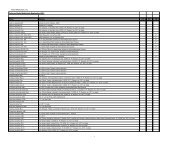Cordyceps - Aloha Medicinals Inc.
Cordyceps - Aloha Medicinals Inc.
Cordyceps - Aloha Medicinals Inc.
You also want an ePaper? Increase the reach of your titles
YUMPU automatically turns print PDFs into web optimized ePapers that Google loves.
8 <strong>Cordyceps</strong><br />
immune function of treated patients, compared to the<br />
untreated control group. [32]<br />
Patients with chronic renal failure or reduced<br />
kidney function often suffer from hypertension, proteinuria,<br />
and anemia. In a study with such patients, it<br />
was found that after one month on C. sinensis, a<br />
15% reduction in blood pressure was observed. Urinary<br />
protein was also reduced. Additionally, increases<br />
in superoxide dismutase (SOD) were seen. The increase<br />
in SOD, coupled with an observed decrease in serum<br />
lipoperoxide, suggests an increase in the oxygen free<br />
radical scavenging capacity, resulting in reduced oxidative<br />
cellular damage. [33]<br />
In another human clinical study, 57 patients with<br />
gentamicin-induced kidney damage were either treated<br />
with 4.5 g of <strong>Cordyceps</strong> per day or by other, more conventional<br />
methods. After six days, the group that<br />
received <strong>Cordyceps</strong> had recovered 89% of their normal<br />
kidney function, while the control group had recovered<br />
only 45% of normal kidney function. The time-torecovery<br />
was also significantly shorter in the <strong>Cordyceps</strong><br />
group when compared with that of the control group. [12]<br />
HYPOGLYCEMIC EFFECT<br />
Another area of particular interest is the effect of<br />
<strong>Cordyceps</strong> on the blood glucose metabolism system.<br />
<strong>Cordyceps</strong> has been tested on animals and humans<br />
to investigate its potential as an agent in blood sugar<br />
regulation. In one randomized trial, 95% of patients<br />
treated with 3 g=day of C. sinensis saw improvement<br />
in their blood sugar profiles, while the control group<br />
showed only 54% improving with treatment by other<br />
methods. [34]<br />
In animal studies, isolated polysaccharides have<br />
been shown to improve blood glucose metabolism<br />
and increase insulin sensitivity in normal animals, [35]<br />
to lower blood sugar levels in genetically diabetic animals,<br />
[36] and to positively affect blood sugar metabolism<br />
in animals with chemically induced diabetes. [37]<br />
The common thread throughout all these trials is the<br />
increase in insulin sensitivity and hepatic glucoseregulating<br />
enzymes, glucokinase and hexokinase.<br />
In one unpublished trial conducted by us on nondiabetic<br />
patients treated with 3 g=day of <strong>Cordyceps</strong>, it was<br />
found that blood sugar levels vary throughout the day;<br />
the increase in blood glucose levels after eating and the<br />
dropping of glucose levels between meals were significantly<br />
dampened in the <strong>Cordyceps</strong> group. This indicates<br />
an increase in the efficiency of the blood sugar<br />
regulation mechanism. Furthermore, it was found that<br />
the subjects who happened to be alcoholic tended to<br />
lose their desire for alcohol within 48 hr after the<br />
commencement of this study. Subsequent unpublished<br />
and ongoing studies by us have confirmed this effect of<br />
reduction in alcohol craving. Further research into this<br />
area is clearly needed.<br />
LUNG AILMENTS<br />
Chinese medicine has characterized C. sinensis as a<br />
guardian of respiratory health for more than a<br />
thousand years. There have been trials on humans,<br />
using <strong>Cordyceps</strong> to treat many respiratory illnesses,<br />
including asthma, COPD, and bronchitis, either alone<br />
or as an adjunct to standard antibiotic therapy, and<br />
in many studies that have been conducted, it appears<br />
to be useful for all of these conditions. [14,48,49,51–55]<br />
Much of its reputation for protecting the lungs,<br />
again, is believed to stem from its ability to promote<br />
enhanced oxygen utilization efficacy. In environments<br />
lacking sufficient oxygen, mice treated with <strong>Cordyceps</strong><br />
were able to survive up to three times longer than those<br />
left untreated, demonstrating a more efficient utilization<br />
of the available oxygen. This provides support<br />
for <strong>Cordyceps</strong>’ long history of use in preventing and<br />
treating altitude sickness. [14] Such efficacy alludes to<br />
the use of <strong>Cordyceps</strong> as an effective treatment for<br />
bronchitis, asthma, and COPD. Extracts of C. sinensis<br />
have been shown to inhibit tracheal contractions,<br />
especially important in asthma patients, as it allows<br />
for increased airflow to the lungs. In addition, its<br />
anti-inflammatory properties may prove to bring<br />
further relief to asthma patients, whose airways<br />
become obstructed, because of an allergic reaction<br />
resulting in the swelling of the bronchial pathways.<br />
[1,12,38] In an unpublished clinical trial conducted<br />
at the Beijing Medical University involving 50 asthma<br />
patients, symptoms among the group treated with <strong>Cordyceps</strong><br />
were reduced by 81.3%, within an average of<br />
five days; while among those treated with conventional<br />
antihistamines, the symptom reduction averaged only<br />
61.1%, and took an average of nine days for symptoms<br />
to subside. [48,38]<br />
HEART AILMENTS<br />
<strong>Cordyceps</strong> is also a medication used in stabilizing the<br />
heartbeat and correcting heart arrhythmias in China.<br />
While the exact mechanism responsible for <strong>Cordyceps</strong>’<br />
reputation with regard to controlling arrhythmias is<br />
not completely understood, it is thought to be at least<br />
partially because of the presence of adenosine, [39] of<br />
which <strong>Cordyceps</strong> often has a significant quantity,<br />
along with deoxyadenosine, related adenosine-type<br />
nucleotides, and nucleosides. It has been shown that<br />
these compounds have an effect on coronary and cerebral<br />
circulation. [40,41] While no single drug or herb is<br />
equally effective in all patients, it appears rare for a




